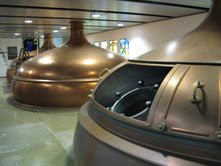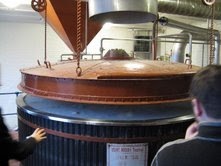
It's an innocuous enough question. Many of my friends have a beer that is near and dear to their hearts. One that conjures up memories of that corner pub in London or the intimate cafe in Amsterdam where they spent some summer evenings years ago. The question has often been posed to me by fellow beer lovers and I have never been able to come up with an answer for them or for myself. Some days I can't imagine anything nicer that a tart
Ommegang Rouge, other days I crave a
Peche Mortel and just yesterday I had a
Moylan's Hopsickle that was quite nearly perfect. There are so many great beers out there that it would seem almost unfair to crown one as the king - especially knowing that next week I'll simply have to change the list.
Over the past few years there are numerous beer rating sites that have cropped up that allow participants to rate their favorite beers, pubs, bottle shops, and brew pubs. I can understand the attraction. These sites have provided a platform and a forum for beer lovers all over the world to discuss and chronicle the great destinations they have visited and the many great beers they have found along the way. These sites have also proven helpful when visiting an unfamiliar city to find that off-the-beaten-path pub with the private stash of vintage beers or the bottle shop with the best selection. There's plenty to like here. It's useful to log on to check the ABV's of a new beer before listing it in the menu or to double-check the exact style of a beer (even though, from time to time, this information proves to be less than accurate).
The problems come in when these sites process the individual ratings and assign a hierarchy to the beers. There is a built-in subjectivity to beer that makes these kind of assertions seem odd at best. Who specifically is assigning the value or importance of particular attributes or ingredients to each style? In a foot race it's easy to say that whoever crosses the finish line first is the fastest, and the second guy or gal is the next fastest, but how are we able to say that Dark Lord Imperial Stout is an objectively better stout than Storm King or Old Rasputin? It would be at least possible to speculate that if all stouts had thousands of ratings that the law of large numbers (a theorem in probability that describes the long term stability of the mean of a random variable) would provide some degree of accuracy but that is rarely, if ever, the case inside of any given beer style category. In the above mentioned example, Dark Lord Imperial Stout is only available to a handful of enthusiasts who are willing to stand in line for hours to have the honor of taking home a 6 pack. On the other hand, North Coast Old Rasputin and Victory Storm King are widely available year round, thus subjecting themselves to a higher degree of scrutiny and also not having the advantage of scarcity that Dark Lord enjoys.
Another recent example would be Westvletteren 12's domination of the top spots on every beer chart for years. This is a beer that is only available at the brewery or pub across the street from the monastery in Belgium and sometimes through select Belgian and Dutch bottle shops that bootleg it. It is in it's own right a legitimately good beer, but there is little question of the weight that is given to scarcity in the online ranking world. In James Surowiecki's recent work 'The Wisdom of Crowds' he makes a compelling argument for the corrective value and relative accuracy of large numbers of people's contribution. Numerous examples are cited that demonstrate how (in theory), at some critical mass, the hopheads would be balanced by the maltheads and the lovers of dry, tart beers would be balanced by the lovers of sweet beers inside of any given style of beer. Even if this were statistically true about many things in life are you really buying it when it comes to beer? Drinking great beer is very much a subjective sensory experience and the enjoyment of it is influenced by so many different factors that are difficult, if impossible, to measure - not the least of which is experience and context.
While recently reading assorted reviews of Cantillon's Rose De Gambrinus a reviewer describes the beer as being 'punishingly bitter with the overwhelming flavor of vomit. Unquestionably the worst Belgian beer ever made'. Granted, Cantillon is by no means for everyone (obviously not for that reviewer) but this review underscores the subjective nature of beer enjoyment. There are plenty of people with an acquired taste for lambics who would argue vehemently with the above reviewer - and they could both be right in their own minds.
It is also painfully obvious that the contributors here are not the beer equivalent of a sommelier. Perhaps some are, but they are very few indeed. That's not to say that there is not value in the collective voice of thousands of amateur beer enthusiasts. There is. My issue with the rating frenzy has more to do with the weight that they carry in the marketplace and oftentimes the way that they marginalize great beers that have been designed for a niche group of drinkers that end up being buried because they are unappreciated by the larger pool of craft beer reviewers (example: Avery Fifteen).
Perhaps the biggest problem with such lists is that they deliver to us the top 50, 100 or more beers that span everything from Pilsners to Belgian Dark Strong Ales. Saying that Chimay Blue is an objectively better beer than Victory's Prim Pils is an inherently ridiculous statement. It's like saying that oranges are 'fruitier' than apples by five points.
Ultimately, it's about enjoying beer and enjoying people in the context of great beer. The overwhelming need to call something #1 seems to defeat the spirit of the brewmaster. Not every beer is built for you. Some you will love, others you will hate and many will go by largely unnoticed. Craft beer is a celebration of the simple things in life. It is not the elegant elixir of debutants but is, historically, a beverage designed for the everyman. The wine industry lacks sorely for innovation and creativity in part because they have built their industry on the narrow and rigid dictates of thought-leaders like Robert Parker. Mr. Parker certainly knows much more about wine than I do and I don't question the discernment of his palate. My point here is, do we really want craft beer companies to stop making cutting edge experimental beers or brewing risky styles because they might be poorly received and effect the overall rating of their brewery?
These sites are full of pages of useful information and provide an arena for thousands of beer enthusiasts to dialog about beer and journal about ones they loved and others they didn't. There is great value in many aspects of what they do and the way that they have worked to galvanize the craft community. Even the most brilliant ideas and solutions can evolve into something they were never intended to be and, if unchecked, can create bigger problems than the ones they were designed to solve.
Think for yourself, drink the beers you love, and never stop exploring.










